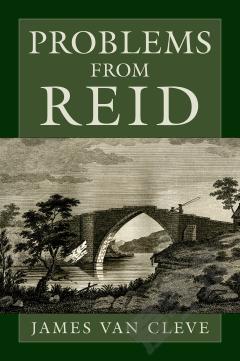Problems from Reid
Acknowledgments Introduction Chapter 1: Sensation and Perception A. Explanations of Terms B. Sensation versus Perception C. Reid's Threefold Account of Perception D The Conception in Perception E. Perception and Belief F. Consciousness and Attention G. Are Sensations Self-Reflexive? Chapter 2: Reid's Nativism A. Reid's Nativism B. Natural Signs C. The Experimentum Crucis D. Responses to the Experimentum Crucis E. Woulds, Coulds, or Shoulds? F. Nativism as an Antidote to Skepticism? Chapter 3: Direct Realism Versus the Way of Ideas A. The Way of Ideas B. First Argument for the Way of Ideas: No Action at a Distance C. Second Argument for the Way of Ideas: Hume's Table Argument D. Third Argument for the Way of Ideas: Double Vision E. Fourth Argument for the Way of Ideas: Malebranche's Master Argument F. Three Forms of Direct Realism G. Do Sensations Obstruct Direct Realism? H. Is Reid a Presentational Direct Realist? I. All Perception is Direct Perception Chapter 4: Primary and Secondary Qualities A. Reid's Relation to Locke and Berkeley B. The Real Foundation: Epistemological or Metaphysical? C. Dispositions or Bases? D. Intrinsic or Extrinsic? E. Fixed or Variable? F. Four Views that Conflict with Reid's Chapter 5: Acquired Perception A. The Mechanics of Acquired Perception B. Is Acquired Perception Really Perception? C. Are Secondary Qualities Objects of Acquired Perception Only? D. Does Acquired Perception Alter the Content of our Original Perceptions? E. Could Anything Become an Object of Acquired Perception? F. Is Reid Inconsistent about the Requisites of Perception? Chapter 6: The Geometry of Visibles A. The Properties of Spherical Figures B. Depth is Not Perceived C. The Argument from Indistinguishability D. Visibles as Sense Data E. Coincidence as Identity F. Angell's Approach G. The Argument of Paragraph 4 H. The Real Basis of the Geometry of Visibles I. Does the Geometry of Visibles Jeopardize Direct Realism? J. What Are Visibles? K. Direct Realism and Seeing What we Touch L. Visible Figure as a Relativized Property of Ordinary Objects M. Mediated but Direct? Chapter 7: Erect and Inverted Vision A. The Naive Puzzle and Rock's Question B. The Classical Solution C. Berkeley's Solution(s) to the Naive Puzzle D. Reid's Alternative to Berkeley's Solution E. Answers to Rock's Question F. Experiments with Inverting Lenses G. Perceptual Adaptation Chapter 8: Molyneux's Question A. Molyneux's Question B. Empirical Evidence C. Berkeley's Answer D. Reid's answer(s) E. Is Berkeley's Modus Tollens Reid's Modus Ponens? F. The One-Two Molyneux Question G. Concluding Confession Chapter 9: Memory and Personal Identity A. Things Obvious and Certain with Regard to Memory B. Critique of the Impression and Idea Theories of Memory C. Memory as Direct Awareness of Things Past D. The Specious Present E. Personal Identity Chapter 10: Conception and its Objects A. Was Reid a Meinongian before Meinong? B. Alternatives to Meinongism: Ideas and Universals C. Alternatives to Meinongism: The Adverbial Theory of Thinking D. A Meinongian Defense of Direct Realism E. Assessment of the Defense F. Direct Realism Redux Chapter 11: Epistemology 1: First Principles A. First Principles and Epistemic Principles B. A Crucial Ambiguity C. Clues from Reid's Discussion of Descartes D. Particulars Versus Generals E. Three Reasons for Particularism F. Other Minds and Natural Signs G. Must Principles Be General? H. Establishing Reliability Without Circularity I. Reid on Confirming the Testimony of our Faculties J. Can Epistemic Principles Be First Principles? K. The Epistemic Status of Reliability Principles L. Conclusion Chapter 12: Epistemology 2: Reid's Response to the Skeptic A. Direct Realism B. Naturalism C. Externalism D. Problems for Externalism E. Rationalist Alternatives F. Conclusion Chapter 13: Epistemology 3: Lehrer's Reid A. Must a Knower Know that his Faculties are Reliable? B. A Special Role for Principle 7? C. Faculties that Vouch for Themselves? Chapter 14: Theory of Action 1: Causation, Action, and Volition A. The Notion of Active Power B. Two Types of Causation C. Universal Agent Causation D. Action and Volition Chapter 15: Theory of Action 2: Determinism, Freedom, and Agency A. Two Forms of Determinism B. What Freedom is not: the Williwig Account C. What Freedom is: the Agent-Causation Account D. The Fundamental Dilemma for Libertarianism E. The Regress of Exertion F. The Regress of Agent Causation G. Anomic Explanation Chapter 16: Reid versus Hume on Morals A. Hume and Reid in the Broad Scheme of Things B. Reid against Hume C. Hume against Reid D. Ethics and Epistemology Appendices A. Is There Knowledge by Acquaintance? B. Conception and Judgment: the Chicken or the Egg? C. Experience as a Source of Concepts D. Perception as Analog Representation E. Byrne versus Reid F. Infinity and Reflexivity G. Externality and Extension H. Programming the Obvious I. The Sun in the Sky and the Sun in my Mind J. Secondary Qualities: Can We Have it Both Ways? K. The One-Point Argument L. Stereo Sue M. Hyperbolic Claims about Hyperbolic Geometry N. What Is Special about the Sphere? O. Is Reid's Geometry Imaginable? P. Forlorn Reflections Q. Ask Marilyn R. Stratton Overturned S. Molyneux's Question Answered after 300 Years? T. Relative Identity U. Locke, Berkeley, Hume, and Reid on Abstract Ideas V. The First Principles of Contingent Truths W. Reid on the First Principle(s) of Descartes X. Rowe's Regress Y. Volition and Undertaking Z. Reid, Chisholm, Taylor, and Ginet Bibliography Index
{{comment.content}}








 京公网安备 11010802027623号
京公网安备 11010802027623号